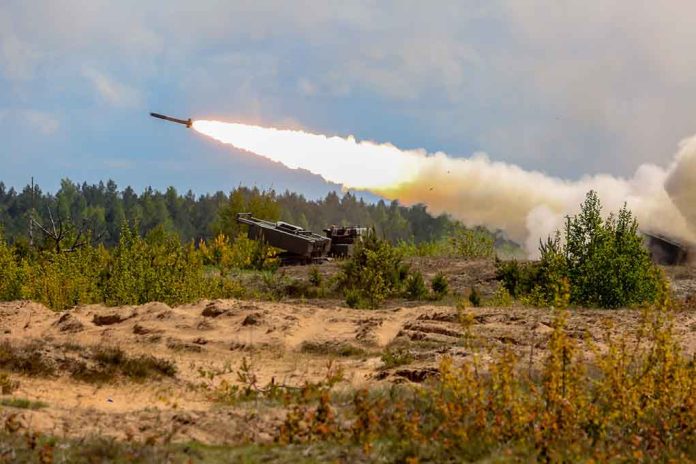
America’s military leaders have sounded the alarm as Tomahawk missile stockpiles rapidly deplete, with officials warning the nation could run out of critical munitions within days of a major conflict with China.
Key Takeaways
- U.S. military officials warn of critical shortages in Tomahawk missiles, torpedoes, and anti-ship missiles amid increasing global demands.
- Pentagon’s inventory is under severe pressure from simultaneous support to Israel, Ukraine, and Taiwan, straining America’s military readiness.
- A military wargame predicted the U.S. could deplete its long-range precision munitions within less than a week in a conflict with China.
- The Trump administration has negotiated a historic $142 billion defense deal with Saudi Arabia to strengthen regional security.
- Manufacturing challenges, including workforce shortages, supply chain issues, and hostile regulatory policies, have undermined America’s defense industrial base.
Military Leaders Sound Urgent Warnings
Acting U.S. Chief of Naval Operations James Kilby delivered a stark warning to Congress about America’s dwindling missile stockpile, emphasizing that operations in the Red Sea have rapidly depleted the nation’s inventory of critical Tomahawk missiles. These precision-guided weapons, essential for long-range strikes, are being consumed at an alarming rate with no immediate production solutions in sight. Kilby further stressed that the nation faces additional shortages in torpedoes and anti-ship missiles, creating a dangerous vulnerability in naval warfare capabilities. The Pentagon’s munitions stocks are under unprecedented pressure as the U.S. simultaneously supports Israel, Ukraine, and prepares for potential contingencies involving Taiwan.
“If we go to war with China, it’s going to be bloody and there’s going to be casualties and it’s going to take plenty of munitions, so our stocks need to be full,” said James Kilby, Acting U.S. Chief of Naval Operations.
The situation has become so dire that military planners are conducting risk management assessments to transition from peacetime to wartime production. Yet experts note that ramping up munitions manufacturing faces significant hurdles. The industrial capacity to produce these sophisticated weapons has atrophied over decades, with defense funding historically prioritizing platforms like ships and aircraft while neglecting the munitions these systems deploy. This strategic oversight has created a dangerous capability gap that cannot be quickly remedied, even with emergency funding.
Wargame Simulations Reveal Critical Vulnerabilities
Pentagon wargaming exercises have revealed deeply concerning scenarios about America’s military readiness. One simulation predicted that in a conflict with China, the United States could exhaust its supply of long-range precision munitions in less than a week. This startling projection contradicts public reassurances from defense officials who maintain that U.S. stockpiles remain robust. The reality facing military planners shows a different picture, with simultaneous global demands creating unprecedented strain on available munitions supplies. Despite these warning signs, the Pentagon has continued transferring significant quantities of bombs and missiles to allies like Israel and Ukraine, further depleting domestic inventories.
“There are very few places where we have what you might call surplus stockpiles,” said Mark Cancian, a senior adviser at the Center for Strategic and International Studies think tank.
The situation is particularly concerning in the Indo-Pacific region, where military planners have identified critical shortfalls in munitions necessary to counter Chinese aggression. Defense experts point out that the problem has persisted for over a decade, with only marginal improvements despite increased attention under both the Trump and Biden administrations. Brent Sadler from the Heritage Foundation notes that these concerns date back to General Mattis’s tenure as Defense Secretary during President Trump’s first term, when related discussions were classified to prevent public awareness of the severity of the shortages.
Trump Administration Takes Bold Action
President Trump has moved decisively to strengthen America’s position in global security affairs, announcing a historic defense sales agreement with Saudi Arabia worth nearly $142 billion. This landmark deal, described as the largest in U.S. history, covers five critical categories, including air and missile defense, maritime security, land forces modernization, and information systems upgrades. The agreement represents a strategic pivot toward strengthening key alliances in the Middle East at a time when American munitions inventories face unprecedented pressure. The Saudi deal aims to bolster regional security while simultaneously creating manufacturing opportunities for American defense contractors.
“Our defense relationship with the Kingdom of Saudi Arabia is stronger than ever under President [Donald] Trump’s leadership, and the package signed today, the largest defense cooperation deal in U.S. history, is a clear demonstration of our commitment to strengthening our partnership,” stated by White House fact sheet.
Republican lawmakers have highlighted the connection between America’s missile shortages and decades of hostile policies toward domestic manufacturing. Representative Eric Burlison pointed directly to excessive regulations from agencies like the EPA and OSHA that have driven critical manufacturing overseas, creating what he described as a national security crisis. The congressman emphasized that President Trump recognizes this fundamental vulnerability, noting that America now manufactures just 11% of the world’s GDP compared to China’s 40%. This manufacturing imbalance directly impacts the Pentagon’s ability to rapidly produce defense-critical materials during times of heightened tension.
The Path Forward
To address these critical shortfalls, defense officials are calling for collaborative efforts with new manufacturers to diversify production capabilities for essential weapons systems. The Biden administration’s approach relied heavily on Congressional funding for replenishment efforts without addressing the fundamental weaknesses in America’s defense industrial base. In contrast, President Trump’s focus on revitalizing American manufacturing aligns perfectly with national security requirements, recognizing that a robust domestic industrial capacity is essential for maintaining military readiness. Experts agree that reversing these dangerous trends will require sustained investment and policy reforms to rebuild America’s defense manufacturing capabilities.
“We have been hostile to our manufacturing sector through our crazy energy policies and crazy EPA regulations and OSHA, right? We’ve driven so much manufacturing overseas, and that’s what Trump has recognized, and it has now become a national security issue,” said Rep. Eric Burlison.
Congress has authorized multiyear contracts for critical munitions to ensure steady demand, but has been hesitant to approve a comprehensive critical munitions acquisition fund that would enable more strategic management of weapons stockpiles. Oklahoma Republican Rep. Tom Cole has warned that the U.S. lacks sufficient munitions for a long-term conflict with a major adversary like China, highlighting the need for increased production of precision-guided, long-range munitions. Military leaders emphasize that full munitions stocks are non-negotiable for national security, requiring immediate attention to production capabilities, supply chains, and workforce development in the defense sector.














